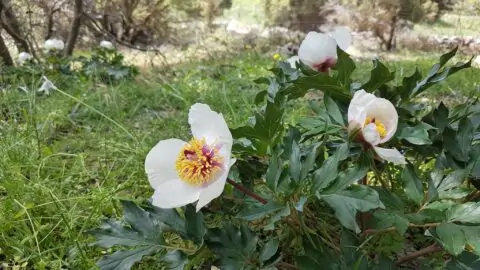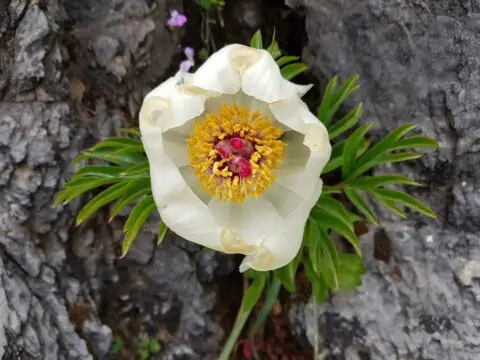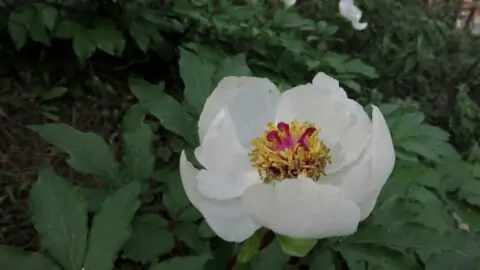[print_posts pdf=”yes” word=”yes” print=”yes”]Paeonia clusii1
Perennials totally glabrous except carpels and occasionally lower surface of leaves. Tap roots thickened, slightly tuberous, up to 2.5 cm in diameter, lateral roots carrot-shaped. Stems usually purple, 25—50 cm tall, with scales several, up to 9 at the base. Lower leaves biternate, all leaflets segmented; segments 23-95 in number, linear, lanceolate to ovate, 5—10 cm long, 0.5—4.5 cm wide, usually glabrous on both sides, rarely hispidulous beneath. Flowers solitary; involucrate bracts 1—2 in number, leaf-like; sepals 3 or 4 in number, ovate-rounded, mostly rounded at the apex, purple at the periphery; petals 7 in number, white, orbicular, oblong or nearly rhomboid, 4-5 cm long, 2.5-4 cm wide; filaments purple; anthers yellow; disk flat, 0.5-1.0 mm high, tomentose; carpels 2-4, rarely 1 in number, tomentose, hairs 2.0-2.5 mm long, pink or brown-yellow; styles 1-2 mm long; stigmas red, 1.5—2 mm wide. Follicles ellipsoid, 3.8 cm long, 1.5 cm in diameter, reflexed when mature. Seeds ovoid—spherical, black, 8 mm long, 5 mm in diameter.
Chromosome number: 2n=10 (diploid) and 2n=20 (tetraploid).
Confined to three Greek islands: Crete, Karpathos and Rhodes
Paeonia cretica Sabine ex Lindl (1824) was described on the basis of material from the Oxford Botanic Garden, but not from Crete, and is synonymous with P. arietina G. Anderson (1818). Tausch (1828) correctly described the plant collected by Sieber from the White Mountains, Crete, using the name P. cretica. Thus, P. cretica Tausch (1828) is an illegitimate name, and was substituted by a new name, Paeonia clusii Stern (1940), named after Clusius, who is the first to mention the white peony in Crete in 1601.
Paeonia clusii is characterised by a high number of leaf segments, total glabrousness (except carpels and very occasionally the lower side of leaves), and white flowers. Stern (1946) stated that the species is similar to the P. officinalis group. Its leaf segments are mostly fine and it resembles the P. officinalis group in appearance but it differs from that group in having roots carrot-shaped, basipetally attenuate, not remarkably tuberous, leaves nearly always glabrous, and flowers white. Its closest relative seems to be P. broteri in the Iberian Peninsula. Both P. clusii and P. broteri have carrot-shaped roots and relatively high numbers of leaflets/leaf segments (11-32 in P. broteri), and they are both diploid and glabrous except for tomentose carpels. Molecular trees show that P. clusii is not closely related to the P. officinalis group, but instead is relatively closely related to the P. broteri and P. coriacea group (Sang, 1995).
This species comprises two allopatric subspecies.
1a. Leaf segments 23—95 in number, linear to lanceolate, up to 2.6 cm, very occasionally 3.2 cm wide : subsp. clusii
1b. Leaf segments 23-48 in number, lanceolate to ovate, 2.5—4.5 cm wide: subsp. rhodia
Paeonia clusii subsp. clusii
Chromosome number: Diploid with 2n = 10 and tetraploid with 2n = 20
Adapted to rather dry habitats, maquis in limestone areas, at altitudes from 200 to 1,900 m. Confined to two Mediterranean islands: Crete and Karpathos.
This subspecies has more and narrower leaf segments than subsp. rhodia.

Copyright Liberto Dario. “Paeonia clusii subsp. clusii is a Cretan endemic found in all the three big mountain complexes of the island. Here from the Lasithi mountains.”
Paeonia clusii subsp. rhodia
Chromosome number 2n = 10 (diploid).
Growing in pine woods at an altitude of 350-850 m. Confined to Rhodes, an eastern Aegean island of Greece.
The subspecies is different from the typical one in having fewer leaf segments (23-48), which are broader, lanceolate to broad—elliptic (2.5—4.5 cm wide).

Copyright Liberto Dario. “Paeonia clusii subsp. rhodia on Rodos island. A, rich soil, open woodland habitat and a strong cinnamon scent to complete the picture for this Rodos and Karpathos endemic.”
Images below: Paeonia clusii subspecies clusii on the island of Crete.
Copyright: Julia Jones from Flowers of Crete.
“In Central and West Crete, all peonies are white. In the East of Crete some are white, many are pink.”
- Hong, De-Yuan. “Peonies of the World. Taxonomy and phytogeography.” Kew: Royal Botanic Gardens, 2010, p. 164-165.[↩]



































